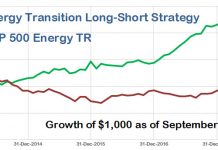Tom Konrad CFA
When Bloomberg New Energy Finance (BNEF) released their clean energy league tables for 2010, the top of the list was my favorite exchange traded fund (ETF), the Powershares Cleantech Portfolio ETF (AMEX: PZD), with an annual return of 7.6%. Second place was the Winslow Green Growth (WGGFX) mutual fund (7.4% return), which is one of what I consider to be the three best clean energy mutual funds. But the one I consider to be the best, the Gabelli SRI Green Fund (SRIGX) was nowhere to be seen, despite the fact that it returned 12.1% in 2010. The third is the New Alternatives Fund (NALFX). (There’s more about why I like these clean energy funds here.)
The discrepancy arises because BNEF and I track different lists (my clean enenrgy mutual fund list is here, and the ETF list is here.) My lists include only US-traded funds, while BNEF’s is global. BNEF also restricts their list to funds that are at least 50% exposed to clean energy. According to a conversation I recently had with John Segrich, SRIGX’s manager, he had mostly moved out of renewable energy companies last year because he was bearish on the sector. This turned out to be a wise move, since most clean energy companies had large losses in 2010, with the Wilderhill New Energy Global Innovation Index (NEX) falling by 14.6% in 2010.
Although still invested in clean energy, Segrich has been holding more resource plays, such as recycling companies, like Horsehead Holding Corp. (NASDAQ:ZINC) and Globe Specialty Metals (GSM), which provides silicon metal to the Photovoltaic and Aluminum industries.
Defining clean energy companies can be tricky, and most industry observers such as BNEF use lists of technologies. I prefer to focus on companies that stand to benefit from increasing resource scarcity and potential, while reducing both global warming and other forms of environmental degradation.
The lack of focus on pure clean energy helped both SRIGX and PZD in 2008. Rafeal Coven, the adviser to the underlying index for PZD, noted that the poor performance of most renewable energy stocks in 2010 was a major reason why Cleantech Index-based funds (such as PZD) significantly outperformed their peers.
Will that trend repeat in 2011? Time will tell, but it pays to understand that the differences between clean energy sectors are often greater than their similarities. In 2010, often overlooked energy efficiency stocks returned 19%, outshining solar stocks (-25%) and blowing away wind stocks (-37%.)
When choosing the best clean energy mutual funds and ETFs, I’ve long used a a large exposure to energy efficiency as one of the most important criteria. When doing a home energy upgrade, the rule is to “Eat your Energy Efficiency vegetables before indulging in a solar power dessert.” The same rule applies when building a clean energy portfolio.
This article was first published on Tom Konrad’s Green Stocks blog at Forbes.com.
DISCLOSURE: No positions.
DISCLAIMER: Past performance is not a guarantee or a reliable indicator of future results. This article contains the current opinions of the author and such opinions are subject to change without notice. This article has been distributed for informational purposes only. Forecasts, estimates, and certain information contained herein should not be considered as investment advice or a recommendation of any particular security, strategy or investment product. Information contained herein has been obtained from sources believed to be reliable, but not guaranteed.








